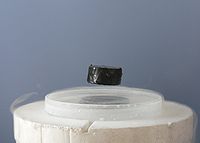
Photo from wikipedia
Abstract Here, the Cu/Al/FTO layered nanostructure was designed and manufactured for investigating the roles of the interface transition layers in its resistive switching (RS) behaviors. The presence of the interface… Click to show full abstract
Abstract Here, the Cu/Al/FTO layered nanostructure was designed and manufactured for investigating the roles of the interface transition layers in its resistive switching (RS) behaviors. The presence of the interface transition layers was confirmed by X-ray photoelectron spectroscopy (XPS) depth profile scans, indeed there is a very thin Al2O3 interface transition layer (interface 1, denoted as I1) produced by the natural oxidation within the Cu/Al interfaces, and a thicker interface transition layer (interface 2, denoted as I2, consisting of Al, Al2O3, SnO and SnO2) generated by interdiffusion and redox reaction between the Al/FTO interfaces. The test results showed that the device, with actual structure of Cu/I1/Al/I2/FTO, could show the evolution of resistive switching behaviors: from irreversible write-once-read-many-times (WORM) characteristics to reversible bipolar resistive switching (BRS) behaviors with negative differential resistance (NDR) effect and subsequent disappearance and recovery of the BRS. Correlation analysis suggests the observed RS behaviors strongly depend on the permanent rupture of pre-existing Al conductive filaments (Al-CFs) in the transition layer I2, and their evolution. This work gives an insight into the role of interface transition layers in RS behaviors and provides a simple way to design and build new sandwiched nanostructure using for nonvolatile memory.
Journal Title: Journal of Alloys and Compounds
Year Published: 2020
Link to full text (if available)
Share on Social Media: Sign Up to like & get
recommendations!